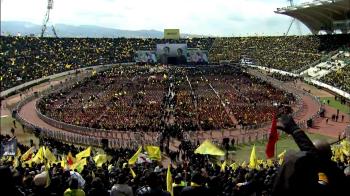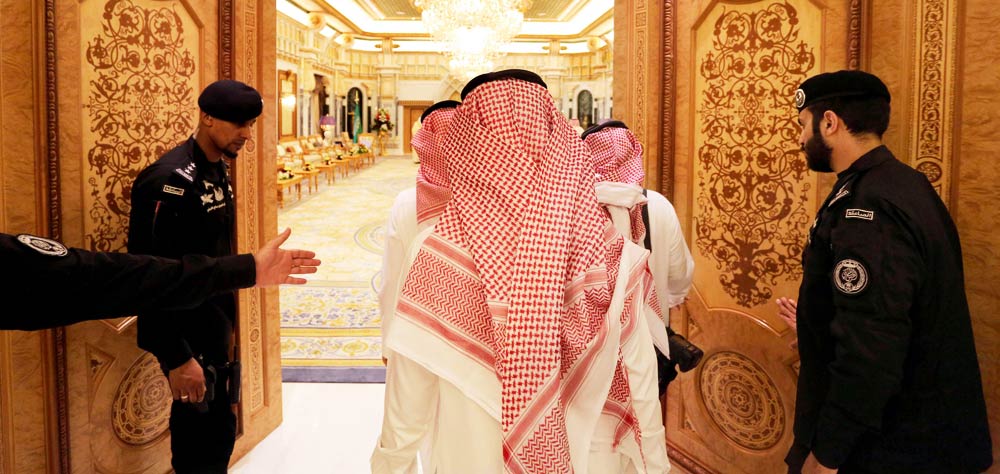Alwaght- Saudi King Salman bin Abdulaziz issued a surprise royal decree on June 21, dismissing Crown Prince Muhammad bin Nayef and giving the post to his young son Mohammad bin Salman. The king’s move marked his breaking with the Arab kingdom’s royalty traditions which do not allow the ruler to install his son as heir to the throne.
Early crown princes in Saudi Arabia were all brothers of the monarch and only one time exceptionally a nephew– bin Nayef– was put to the post.
The closed political circles of Saudi Arabia declined to allow out any news of the reactions to the decision of the monarch to set in motion unprecedented reforming of the ruling structure, but some signs coming out of the court laid bare the fact that his measure could not go unchallenged.
Videos of the day of royalty's allegiance pledging to the young prince were published online, including a footage depicting a prince who very unusually by finger moves told off the new crown prince. A report published by New York Times also signaled that the former crown prince was put under house arrest as he and other princes in his orbit failed to say yes to the new reforms to the Al Saud ruling family’s deeply-established political frame.
Now that King Salman’s radical reshuffle of the ruling regulations have brought him certain opposition inside the court, some questions look come down: How will bin Salman's future among the other ruling family’s members look like? Will he be able to shrug off the tough challenges ahead and make his way to the throne or his plan to deal with likely bitter internal tensions will fail?
To answer these questions, we need to first examine the unofficial structures of power in Saudi Arabia.
Multi-family Al Saud: kingdom’s first unofficial layer of power
The Saudi Arabian ruling family, called Al Saud, is comprised of tens of big and small families. Al Saud are all sons of the King Abdulaziz bin Saud, the founder of regime. The family takes its name from its founding father Mohammad bin Saud who took the initial ruling steps in Diriyah town near the modern-day Riyadh. So it is quite normal that with regard to the familial roots of the Saudi government’s structures even in the 21st century the family today presents itself as the main unofficial power-holding apparatus.
Four families inside the structure of Al Saud are the most powerful among others. The first and leading one is Al Faisal. The family is made of the grandsons of Abdulaziz, the grandfather of Faisal bin Turki. Their number goes beyond 4,000. After assumption of the power by King Fahd in 1982, the weightiest branch of Al Faisal has been Sudairi family, also known Sudairi Seven, meaning seven brothers. During the past 30 years, the Sudairi family has been subject of focus of many political analysts. King Fahd came from Sudairi family. It is one of the oldest clans of the kingdom whose bonds with Al Saud bought it further credibility. When King Fahd died in 2005, the Sudairi Seven were reduced to six. King Abdullah bin Abdulaziz succeeded Fahd. He picked his stepbrother Prince Sultan, the oldest of the Sudairi six, as crown prince. But Sultan died in New York in October 2011 before he could see his own ascension to the throne.
Second important branch of Al Saud is Al Thunayyan. The Al Thunayyan hold a significant position in the kingdom’s power structure as they are close to the Sudairi family. Just unlike Al Faisal that hold the political and military power, the Al Thunayyan hold civilian power. They owe another part of their clout to their casual relationship with Al ash-Sheikh family.
The Al Saud's third top branch is Al Jiluwi. One of the apparent intra-Saud differences stems from discords of Al Jiluwi with Al Faisal and Al Thunayyan, dating back to 1960 when some Al Jiluwi members joined forces with princes and scholars from other families and revolted against Al Faisal family rule. The uprising followed Al Jiluwi's bitter criticism of Al Faisal policies. After King Faisal assassination in 1975, the Al Jiluwi struggled for seizing the rule which they argued was their right.
The fourth branch is Al Kabeer. Just unlike the three other branches which are Abdulaziz grandsons, this one is an offshoot of Saud Al Kabeer, the first cousin of Abdulaziz. This family’s princes never bade for succession.
Therefore, among the four branches of Al Saud, only two, Al Faisal and Al Thunayyan, hold the power, with the latter largely holding civilian and cultural sway across the kingdom. This means that only Al Faisal hold the potentials to build up their political power. If challenges are to be posed to the Prince Mohammad bin Salman, they come from Al Faisal. Having in mind that the Sudairis are the strongest branch of the Al Faisal family, very likely the future challenges to bin Salman’s power seizure attempts will come from the Sudairis themselves.
Challenging bin Salman could crack the Sudairis who since King Fahd's power assumption in 1982 have absolutely held the throne. Two camps can stand face to face, with the conservative Sudairis standing on the one side and the bin Salman-led young Sudairis standing on the opposite side.
Other unofficial segments of power: from religious apparatus to business circles
Beside the royal family in Saudi Arabia, there are four groups, including the Wahhabi scholars, tribal leaders, traders and businessmen, who each gained significance and a considerable role in the unofficial layers of power during a period of time due to strategic links to the Al Saud ruling body.
In the religious apparatus, the Council of Senior Scholars (CSS) with its 21 members, all picked by the king for certain time, is a top body. Following the Hanbali school, one of the four Sunni Islam schools, the Council adopts ideology of Ibn Taymiyyah and Muhammad bin Abd al-Wahhab, extremist Sunni scholars who respectively lived in 14th and 18th centuries. The CSS is the most conservative religious institution in the kingdom.
Imam Muhammad ibn Saud Islamic University (IMISIU) is the second religious institution with the largest influence. Due to its academic nature, the IMISIU holds more open views than other religious references.
There are also the charity organizations that serve the government’s cultural diplomacy beyond the country’s borders. They operate under the cover of charity aiding to fight poverty in Muslim countries and pave the way for Muslim nations' development, but in reality they serve a proselytization policy of the Wahhabism and Al Saud abroad. This means they are always under sway of the ruling family.
The business activities in Saudi Arabia range from the government’s oil sales to the businessmen's massive food and clothing imports. The royals exclusively lead the business activities in Saudi Arabia, something that was boosted during King Abdullah period. The major Saudi business circles account for a main part of the power in the unofficial layers of the political structure.
The difficult but realizable throne dreams
King Salman’s struggles to raise his son, an ambitious young prince, to the power are facing challenges, but succession is not unfeasible. The king and his son have ahead the hard job of passing the filters of the leading powerful families that oppose Salman power manipulation. Following ousting bin Nayef and installing bin Salman, the conservative Sudairis felt serious threats to their position, and are, the analysts note, far from staying silent at least in the future in the face of the power monopolization by the 31-year-old bin Salman.
Records of coup and assassination exist in history of Al Saud ruling. King Saud and King Faisal were removed from power using these methods. Experts do not rule out resorting to these methods to confront King Salman’s unorthodox measures of dismissing two crown princes to pave the way for his son's power seizure. Bin Salman has to deal with the traditional Sudairi family which ruled the country for three consecutive decades but all of a sudden was stripped of power.
Despite the roadblocks, bin Salman have some reasons to stay optimistic about holding the power after his father. The CSS, once the strongest religious body with firmly conservative views inside the kingdom, lost its significance following some tradition-breaking policies implemented by King Abdullah. Now the pro-Mohammad IMISIU serves as the CSS's replacement in terms of influence and importance.
The academic communities' power gain provides bin Salman with a scope to strengthen his place among the young generations, rather than seeking drawing support of the conservative scholars. Bin Salman’s academic record in King Saud University can show his optimism about attracting academic circles' support. He founded Mohammad bin Salman College for Business and Entrepreneurship in King Abdullah Economic City in show of efforts to bolster contacts with the academic communities. This is an advantage for the ambitious prince while the CSS is losing sway.
Bin Salman has also launched an unprecedented campaign to attract the investors and creep closer to the business circles. The Saudi Vision 2030 initiative that seeks reforming the country’s largely oil-based economy, including Aramco oil giant's IPO listing, is expected to give rise to a new layer of moneyed class supportive of the young prince. Certainly, the royal rich people will show backing for the rising prince’s economic plans as they seek saving their wealth. Support to bin Salman by the rich classes will formally mean support for the crown prince post.
The main challenge to bin Salman’s bid for the throne while eyeing the support of the new unofficial business and academic, and religious orbits remains posed by the conservative Sudairi family. However, so far it declined to react sharply to the king’s breaking with the entrenched succession rules as well as prince’s excesses. Should this current trend continue by father and son, the traditionalist Sudairis will be gradually driven to the sidelines.



























